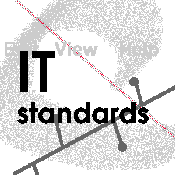
Issues: Electronic Data Interchange Standards
By Joan O. Pupik
Issues Surrounding the EDI Standard
Use of the Internet
The EDI standards are independant of the media used for transfer of data. The Internet is the newest media to be proposed for use in EDI transactions. The Internet Task Force covers this topic in detail in "EDI Meets the Internet" RFC1865 and "MIME Encapsulation of EDI Object" RFC1767.Concerns have been raised regarding using the Internet for EDI. Since the data being transmitted could contain business sensitive information , the users must be assured of the privacy and security of their transmissions. Increased traffic could hamper Internet use, but EDI transactions could be handled by batching at off hours, inproving the utilization of the Internet.
PC Week believes that "The key beneficiaries of the buildup of Internet infrastructure-electronic commerce and business-to- business commerce-will continue to grow in '97, but are not primed for huge growth until next year."
Use of the internet opens the option of using EDI to small businesses. This equal access could expand the role of the government in the use of EDI. It could improve productivity and competition among suppliers.
Security
Using dedicated transmission lines EDI is relatively secure, but the movement to the Internet has created concerns for security.The perception that the Internet is not a safe place to conduct business transactions has placed emphasis on the development of a variety of security measures to bring trust to Internet commerce. Encryption, key recovery, digital signatures, tunneling technology, Secure/Multipurpose Internet Mail Extension (S/MIME) and Secure Electronic Transaction (SET) all seek to make the Internet safe for business transactions.
X12 or EDIFACT
How important is single international standard? X12 is accepted and used in the United States. EDIFACT is the recommended standard for the future. Users do not need to drop X12 and move to EDIFACT. As Libicki points out "Although a single form is more efficient to support than one for every customer, the burden of supporting two forms is not so painful, particularly if EDI software vendors support both. Software to translate between X12 and many other standards is plentiful. As long as X12 and EDIFACT data elements are consistent with the way vendors and users keep data, the choice between them can be made transparent to the user."
Summary
ANSI X12 has been a reasonably successful standard. This is due to several factors:- X12 did not try to solve everything at once. The standard evolved by accepting industry specific requirements as subsets. For example, in 1989 grocers merged with X12 and ANSI accepted their UCS transaction sets and grocer-specific definitions. Drug manufactures accepted more complexity than needed to comply. Trade groups accepted the requirements of each other. As a result, no new proprietary industry standards have been developed outside X12 since the early 1990s.
- EDI transactions are based on the well defined metaphor of business forms. Each data element in the EDI transmission corresponds directly to a specific piece of information on the appropriate business form.
- EDI transactions are enclosed in an electronic envelope defined by the hierarchical structure of the information. Data elements are contained within data segments, within transaction sets, within functional groups, within an interchange envelope.
- EDI is table driven, which means that versions can be changed by updating the table and not the software logic that operates on the table. This makes it basically compatible with any system. Legacy systems work on newer versions of EDI, making upgrading easier.
EDI has evolved by adapting to the needs of the users. It has proved to be a worth while way of doing business for many. Now it is adapting to the needs of international trade by moving toward a single standard. EDI is a good example of how competitive cooperation and involving the users in the process can work in standards development.
The media has changed over the years and continues to change as the Internet is explored as a possible media for EDI. This increase in network externality will add value as more users participate in EDI.
Spring proposes a reference model for data interchange on a broader plane using "layering, scoping, separation of representation from operation and recognition of metastandards and their families of derivative standards". EDI conforms to this model and has demonstrated an ability to grow and adapt to change.
Return to Main Page of EDI
IT Standards Home
3/17/97
UNDER CONSTRUCTION
jop@lis.pitt.edu